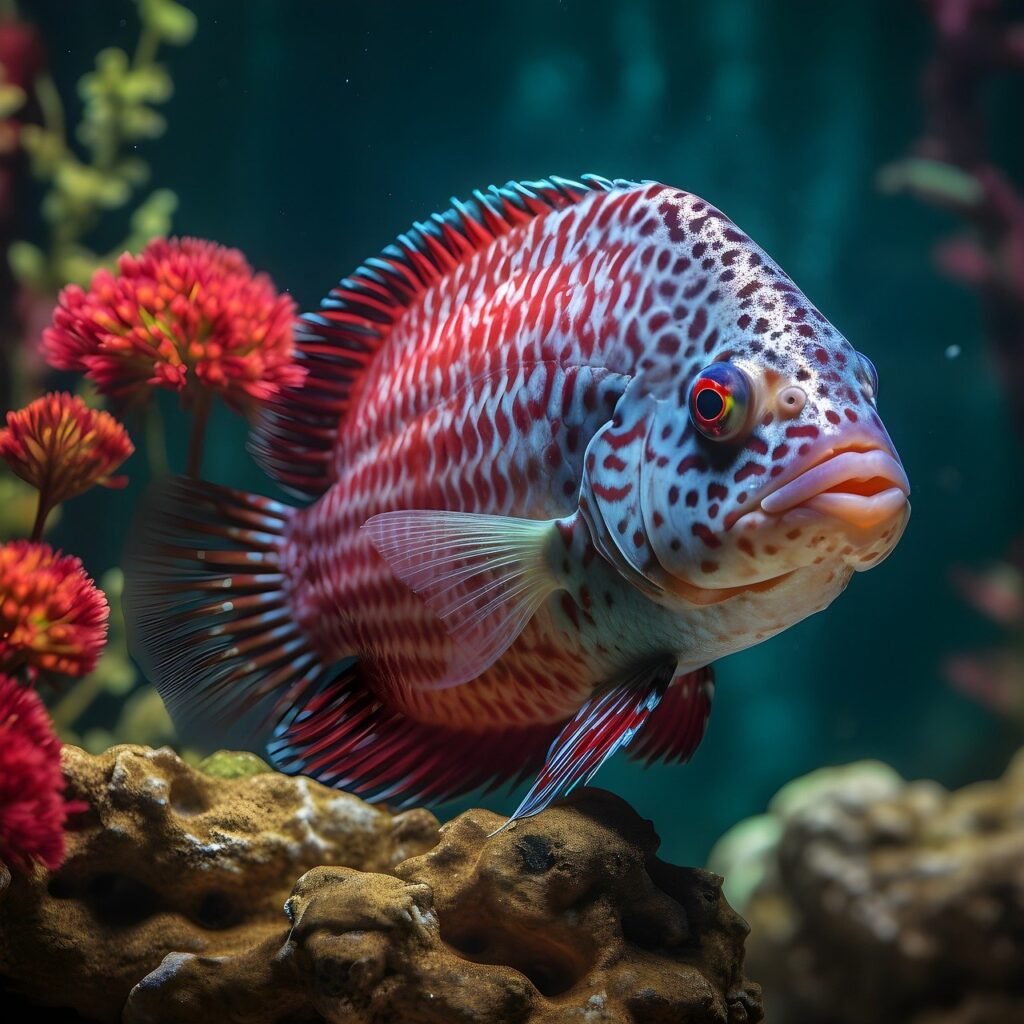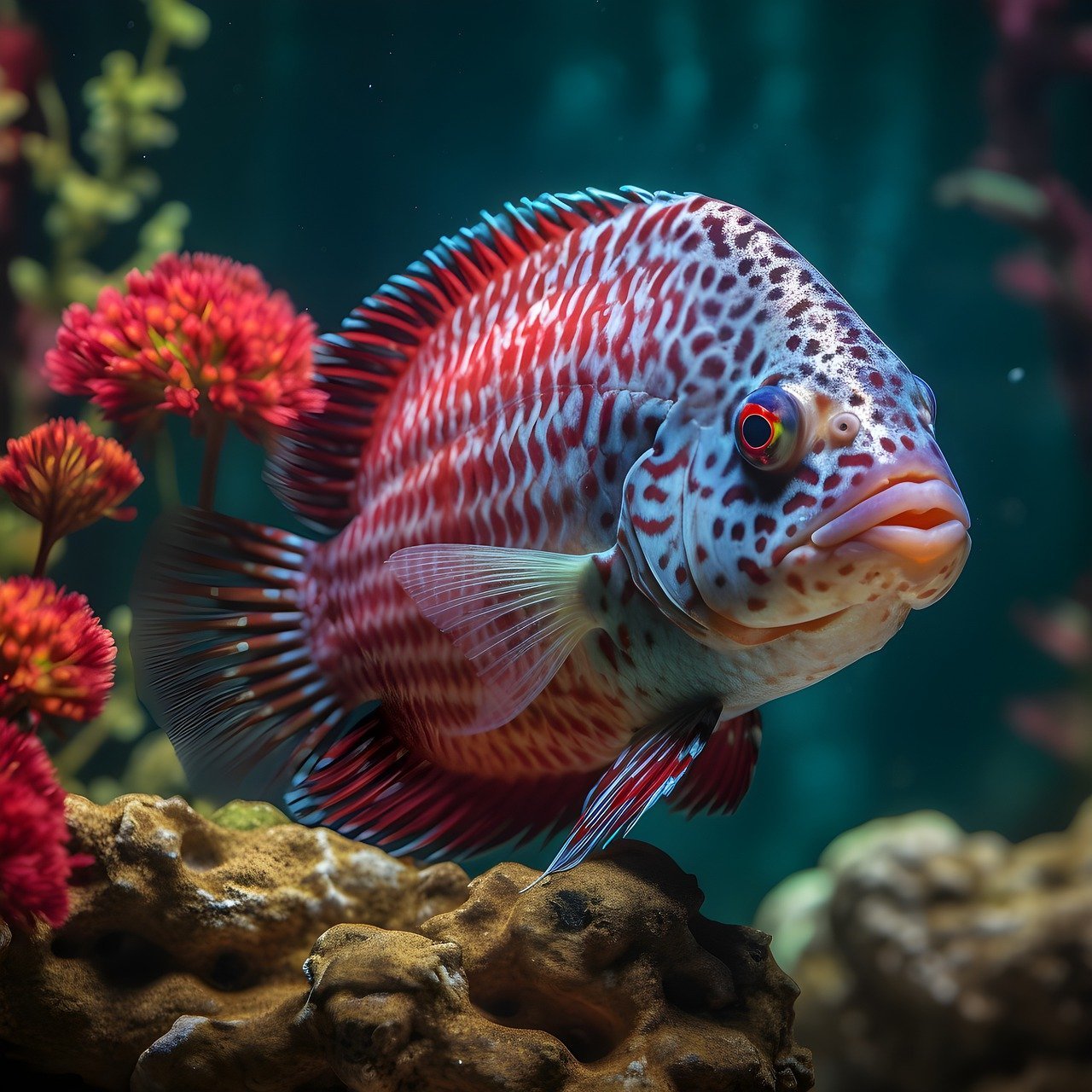The Blue Severum Cichlid (Heros efasciatus), also known as the Turquoise Severum, is a popular and striking freshwater fish. Its unique coloration and relatively peaceful nature make it a favorite among aquarists. In this comprehensive guide, we will delve into everything you need to know about caring for Blue Severum Cichlids, including their natural habitat, tank setup, feeding, breeding, and common health issues.
Introduction to Blue Severum Cichlids
Blue Severum Cichlids are a color variant of the Heros efasciatus, native to the Amazon River Basin in South America. They are admired for their blue-green hues and intricate patterns. These cichlids can grow up to 8 inches in length and live for 10-15 years with proper care. Their beauty and manageable temperament make them an excellent choice for both beginners and seasoned fishkeepers.

Natural Habitat and Behavior
In the wild, Blue Severum Cichlids inhabit slow-moving waters with dense vegetation. They prefer slightly acidic to neutral pH levels (6.0-7.0) and temperatures ranging from 75-82°F (24-28°C). These cichlids are generally peaceful but can become territorial, especially during breeding seasons.
Tank Setup for Blue Severum Cichlids
Creating an ideal environment for your Blue Severum Cichlid is essential for their health and well-being. Here are the key considerations for setting up their tank:
Tank Size
Due to their size and active nature, Blue Severums require a spacious tank. A minimum of 55 gallons is recommended for a single adult, but a larger tank (75-100 gallons) is preferable if you plan to keep multiple Severums or other tank mates.
Water Parameters
Maintaining stable water conditions is crucial for the health of your Blue Severum. Aim for the following parameters:
- Temperature: 75-82°F (24-28°C)
- pH: 6.0-7.0
- Hardness: 4-10 dGH
Use a reliable aquarium heater to keep the temperature consistent and a water testing kit to monitor pH and hardness levels regularly.
Filtration and Aeration
A robust filtration system is necessary to keep the water clean and free of toxins. Canister filters or high-quality internal filters are recommended. Additionally, ensure proper aeration with an air pump or a sponge filter to maintain oxygen levels.
Substrate and Decor
A sandy or fine gravel substrate is ideal for Blue Severum Cichlids. Provide plenty of hiding spots and territories using driftwood, rocks, and caves. Live plants can also be added, but choose hardy species like Anubias or Java Fern, as Severums may uproot or nibble on softer plants.
Lighting
Moderate lighting is sufficient for Blue Severums. Avoid overly bright lights, as these fish prefer dimmer conditions that mimic their natural habitat. Use a timer to maintain a consistent day-night cycle, with 8-10 hours of light per day.
Feeding Blue Severum Cichlids
Blue Severums are omnivorous and require a balanced diet to thrive. In the wild, they feed on a variety of foods, including insects, crustaceans, plant matter, and detritus. In captivity, offer a diverse diet to meet their nutritional needs:
Primary Diet
- High-Quality Pellets or Flakes: Choose a reputable brand formulated for cichlids, ensuring it contains a good balance of protein and other nutrients.
- Frozen or Live Foods: Supplement their diet with bloodworms, brine shrimp, and daphnia to provide essential protein and stimulate their natural hunting instincts.
- Vegetables: Offer blanched spinach, zucchini, peas, or lettuce to provide necessary fiber and vitamins.
Feeding Schedule
Feed your Blue Severum 2-3 times a day, offering only as much food as they can consume in a few minutes. Overfeeding can lead to water quality issues and health problems.
Breeding Blue Severum Cichlids
Breeding Blue Severums can be a rewarding experience, but it requires careful planning and attention to detail. Here’s a step-by-step guide to successfully breeding these fish:
Selecting a Breeding Pair
Start by selecting a healthy, mature pair of Blue Severums. Look for bright colors, clear eyes, and active behavior. Males are typically larger and more vibrant than females, with pointed dorsal and anal fins.
Breeding Tank Setup
Set up a separate breeding tank with a capacity of at least 40 gallons. Maintain the following conditions:
- Temperature: 78-82°F (25-28°C)
- pH: 6.0-6.5
- Substrate: Use a smooth, flat rock or slate for the female to lay her eggs on.
- Filtration: Use a sponge filter to avoid harming the fry.
Spawning Process
Once the breeding pair is introduced to the tank, they will start to court each other. This may involve circling, fin flaring, and cleaning a flat surface for egg laying. The female will lay hundreds of eggs, which the male will then fertilize.
Caring for Eggs and Fry
Both parents will guard the eggs, which will hatch in 3-5 days. Remove the parents after hatching to prevent them from eating the fry. Feed the fry with infusoria or liquid fry food initially, and gradually introduce baby brine shrimp as they grow.
Common Health Issues and Treatments
Blue Severum Cichlids are generally hardy, but they can be susceptible to various health issues if not properly cared for. Here are some common problems and their treatments:
Ich (White Spot Disease)
Symptoms: White spots on the body and fins, rubbing against objects. Treatment: Raise the tank temperature to 86°F (30°C) for several days and add an ich treatment medication. Perform regular water changes to remove parasites.
Hole-in-the-Head Disease
Symptoms: Small pits or holes on the head and lateral line. Treatment: Improve water quality and diet. Treat with medications containing metronidazole or other antiparasitic agents.
Bacterial Infections
Symptoms: Red streaks, ulcers, or fin rot. Treatment: Quarantine affected fish and treat with broad-spectrum antibiotics. Maintain pristine water conditions to prevent recurrence.
Compatible Tank Mates for Blue Severum Cichlids
While Blue Severums are relatively peaceful, choosing the right tank mates is crucial to avoid aggression and stress. Here are some compatible species:
Peaceful Cichlids
- Angelfish
- Blue Acara
- Keyhole Cichlid
Community Fish
- Tetras (Larger species like Congo Tetras)
- Silver Dollars
- Plecos
Avoid
- Aggressive Cichlids (e.g., Jack Dempseys, Oscars)
- Small, delicate fish (e.g., Neon Tetras, Guppies)
Severum Cichlid Colors and Varieties
Natural Color Variations
Severum Cichlids exhibit a range of natural color variations, often depending on their geographical origin and genetics. Common colorations include:
- Green Severum Cichlid: Displaying a greenish body with possible red or orange hues on the fins and face.
- Gold Severum Cichlid: A bright yellow or gold body with potential red markings on the fins.
- Red Severum Cichlid: Featuring red spots or patches, often on a green or yellow background.
- Rainbow Severum Cichlid: Care, Habitat, and Breeding
- Turquoise Severum Cichlid : Care, Habitat, and Breeding
- Blue Severum Cichlid: Care, Habitat, and Breeding
Conclusion
Blue Severum Cichlids are a stunning addition to any freshwater aquarium, offering vibrant colors and engaging behaviors. By providing a suitable habitat, balanced diet, and attentive care, you can enjoy the beauty and charm of these fish for many years. Whether you’re a novice or experienced aquarist, the Blue Severum Cichlid is sure to captivate your interest and bring life to your aquarium.
Discover more from EMMOCEB
Subscribe to get the latest posts sent to your email.






